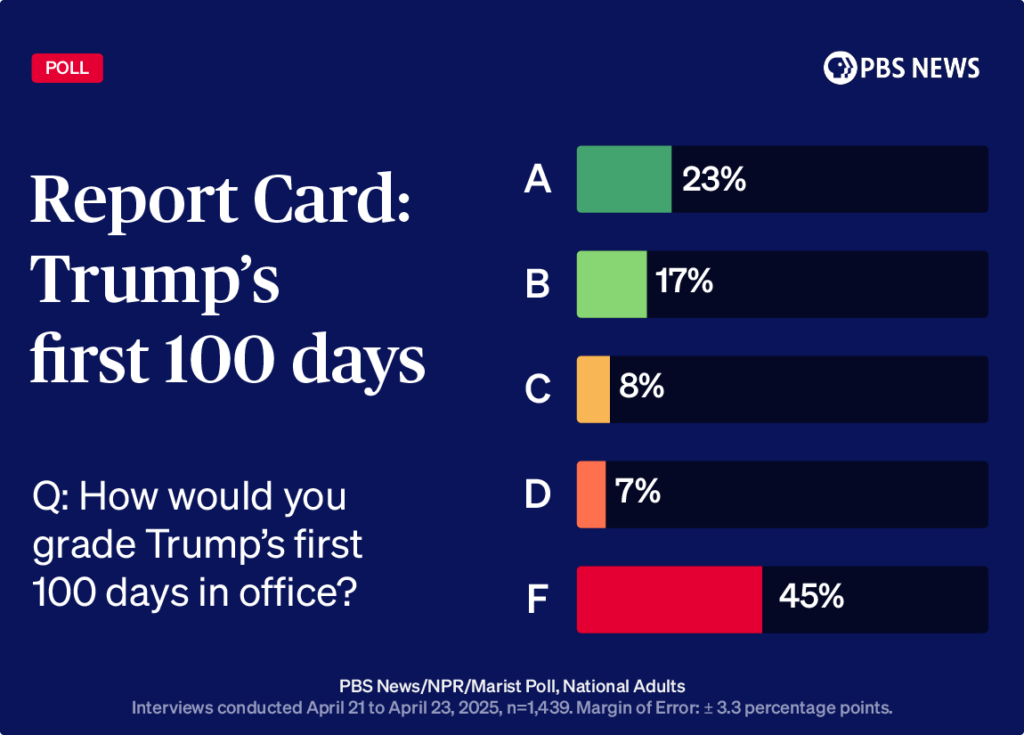The Trump administration will continue to sway as it seeks new equilibrium amid stress-relieving turbulence. Historical patterns can be seen, but so can evolving realities. No one knows if America will find another escape route.
Trump gets an ‘F’ on his first 100 days from plurality of Americans, MaristPoll finds
Almost 100 days into Donald Trump’s second term, the U.S. president has gone through botched attempts at mediating the Russia-Ukraine conflict to erratic flip-flops on so-called reciprocal tariffs. Americans have experienced unease over abrupt agency closures, chaotic decision-making, absurd information leaks, market volatility, surging inflation and street protests. The crises have piled up relentlessly.
Recently, Trump all but admitted failure in his war mediation efforts and signaled a potential U.S. withdrawal from the Russia-Ukraine talks. This contrasts starkly with his campaign promise to “resolve the conflict with one phone call.” Polls now show his approval ratings at all-time lows, with support for his economic policies hitting rock bottom. In short, with a series of miscalculations and failures, Trump’s new deal is devolving into a meltdown, a chaotic start not experienced by any previous U.S. president.
While Trump sits in the eye of this storm, the roots of the chaos run deeper. To understand it, we must zoom out and examine America’s internal struggles and its shifting global role from a historical perspective.
First, the chaos reflects the inevitable release of pent-up stress from unresolved crises: the 2007 subprime crash, the 2019 global pandemic and the 2021 Capitol riot. There seems to be a regular pattern in U.S. history: major crises being resolved with seismic shocks. The Vietnam War’s economic fallout was partly addressed by Nixon’s drastic policies, which upended global financial and trade systems. The 9/11 attack, another major security crisis, was met with a global anti-terror war and two hot wars in Afghanistan and Iraq, making no end of trouble for the future.
Nearly two decades ago, the United States papered over systemic flaws exposed in the real estate market rather than fixing them, with many underlying problems left unaddressed to this today. Mistakes were made one after another in managing the COVID-19 pandemic. And then there was the Capitol riot, an eye-popping political nightmare that laid up trouble for the future. As stress built, the tectonic compression had to be released through several ruptures, but correcting the accumulated defects in the American system will require a major earthquake. Today’s chaos is the natural result of these combined defects, and Trump’s return to power is right at the epicenter.
Second, aside from the many crises, America faces entrenched challenges that demand sweeping whole-of-society reforms. The lack of easy fixes and the need for urgent action have cornered the country. Take the debt crisis, for example. Since the Reagan era, debt has been a perpetual issue. Ronald Reagan’s neo-liberal policies spurred not only growth but also higher debt. Bill Clinton’s tech-driven boom and fiscal discipline briefly balanced the national budget, only to be undone by George W. Bush’s tax cuts and two wars. Since then, U.S. debt has skyrocketed, with quantitative easing, pandemic relief and other “trouble-shooting” spending, ballooning to $36 trillion today.
Why can’t the U.S. solve its debt problem? Because its economy is trapped in a cycle of policy dependency. Growth is not possible without stimulus, but continuous stimulus inflates debt and deficits. Debt risk is growing, and reducing it could well trigger an even greater risk. Trump, the alleged businessman, has expressed confidence in addressing corporate debt. But while he should have some knowledge about revenue increases, spending cuts, debt restructuring and expanded financing, he should also know better than most that raising revenue and cutting spending provoke domestic backlash. He should know that restructuring debt alienates global creditors and that expanded financing will test U.S. creditworthiness. All of this is expensive and politically fatal. Only a president with absolute authority could push such reforms. That is why Trump’s measures appear revolutionary, yet lack true transformative depth.
Third, as changes unseen in a century accelerate, America’s relations with the rest of the world cannot remain unchanged. The country must redefine its global role. Americans do debate their strategic options — isolation vs. engagement, expansion vs. retrenchment, East vs. West — and how to relate to Europe, Russia and, in particular, a rising China. The debate has been going on for more than 20 years. The American perception of China has completely changed. Now, facing multiple options, the U.S. seems ambivalent: It clings to hegemony, while refusing to pay the costs; it attempts to retrench while remaining wary of rivals; and it sets its eyes on Asia, yet frequently glances at its Western allies. Ongoing conflicts in Ukraine and Gaza reveal the unpleasant truth that even a superpower hegemon will struggle to juggle multiple crises.
The second Bush chose a different strategy, and Barack Obama began retrenchment. Neither was fully committed to their respective course. Trump’s solution represents a much sharper break from America’s past global image.
“America first” dictates relations with allies, major powers, neighbors and institutions such as the UN and WTO. It manifests itself in indiscriminate tariffs, over-the-top mediation in Ukraine and brazen rhetoric on Greenland and the Panama Canal. Yet on China, Trump’s statements in April seem to suggest the U.S. is not in a position to stomach an abrupt decoupling. For Trump, the pressure brought by a tariff war with China far exceeds other foreign policy challenges. It demands caution.
In summary, America’s periodic pressure relievers trigger upheaval. Escaping traps requires reform. Balancing relations breeds uncertainty. With 100 days behind it, the Trump administration will continue to sway amid turbulence as it seeks new equilibrium. Historical patterns can be observed, along with evolving realities. No one knows if America will find another escape route. That will depend not only on the U.S. itself but also on how the world responds.

